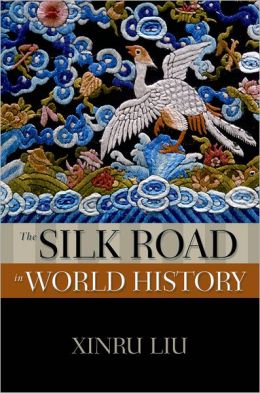On Wednesday, November 13th, eleven members of the History Book Club met to discuss The Silk Road in World History by Xinru Liu.
We began talking about the beauty of silk, especially the long-strand silk originally found only in China. Silk has a special sheen, and its protein structure takes protein dies very well. In many ancient cultures, beautifully dyed and embroidered silk garments clearly distinguished the affluent and important from the common folk. They were expensive, but for people seeking to stand out from the crowd, the expense was justified.
The book is "big history". It shows how trade, governance, culture and technology interacted over more than a millennium from Rome to China.
The group felt that goods tended to move bit by bit across the silk road; a merchant would obtain trade goods in his local marketplace, carry them along the silk road (route in his location), and trade them in the marketplace in his destination. A silk garment might pass through many hands as it traveled from China to Rome, and Roman trade goods similarly might be traded in many marketplaces en route to China. Note that in each market, barter might be necessary as there was no legal tender that was good across the silk road. In the case of ship born trade, a book was eventually developed on the basis of experience describing the goods sought and sold in each of the various ports along the marine trade route.
We discussed religion, noting the importance of Buddhism for the development of the silk road, but also the expansion of Buddhism along the silk road.
One member pointed out that the monotheistic religions of Judaism, Christianity and Islam all demand adherence to specific beliefs of their members and are evangelical, while polytheistic Asian religions are more permissive as to to individual beliefs. Buddhism notably was based on the idea that the Buddha was a human being who showed a path that could be and would be followed by many successors.
Another member was struck by a convergence. A school of Buddhism developed the theory that people could gain spiritual merit by making gifts to Buddhist monasteries. Our book for January, The Reformation: A History by Diarmaid MacCulloch, notes the theory developed by the Catholic church that people could gain spiritual merit by endowing churches and masses and purchasing indulgences.
The great set of websites identified in the back of the book was appreciated. The author, Xinru Liu, appeared to have great knowledge of Asian history, but seemed to us to have made some errors with respect to European history.
We felt that the book would have been greatly improved by the inclusion of better maps. One member mentioned that he would have preferred a more quantitative treatment of the material.
One of our members provided this blog post on the book.
A member provided a Silk Road Timeline and three maps of the silk road (map 1, map 2, map 3).
We began talking about the beauty of silk, especially the long-strand silk originally found only in China. Silk has a special sheen, and its protein structure takes protein dies very well. In many ancient cultures, beautifully dyed and embroidered silk garments clearly distinguished the affluent and important from the common folk. They were expensive, but for people seeking to stand out from the crowd, the expense was justified.
The book is "big history". It shows how trade, governance, culture and technology interacted over more than a millennium from Rome to China.
- Commercial linkages, once established, survived changes in governance.
- Large states, including China, Persia, the Byzantine Empire, the Islamic states, and Rome all provided safety for caravans using the trade routes under their authority.
- The technology, which changed with the development of better ships and understanding of wind patterns, and which benefited from the domestication of the Bactrian camel in the 3rd century bc.
- Culture, including the cultural value of silk. Buddhist monasteries provided early sanctuary for traders in the subcontinent, and with the development of Buddhist practice of endowing monasteries with silks and jewels, new markets for trade goods.
The Silk Road
 |
| Source: The Geography of Transport Systems |
We discussed religion, noting the importance of Buddhism for the development of the silk road, but also the expansion of Buddhism along the silk road.
One member pointed out that the monotheistic religions of Judaism, Christianity and Islam all demand adherence to specific beliefs of their members and are evangelical, while polytheistic Asian religions are more permissive as to to individual beliefs. Buddhism notably was based on the idea that the Buddha was a human being who showed a path that could be and would be followed by many successors.
Another member was struck by a convergence. A school of Buddhism developed the theory that people could gain spiritual merit by making gifts to Buddhist monasteries. Our book for January, The Reformation: A History by Diarmaid MacCulloch, notes the theory developed by the Catholic church that people could gain spiritual merit by endowing churches and masses and purchasing indulgences.
The great set of websites identified in the back of the book was appreciated. The author, Xinru Liu, appeared to have great knowledge of Asian history, but seemed to us to have made some errors with respect to European history.
We felt that the book would have been greatly improved by the inclusion of better maps. One member mentioned that he would have preferred a more quantitative treatment of the material.
One of our members provided this blog post on the book.
A member provided a Silk Road Timeline and three maps of the silk road (map 1, map 2, map 3).

No comments:
Post a Comment